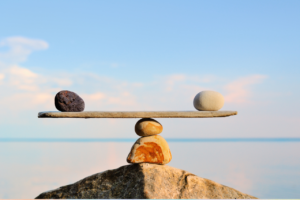Go With The Flow: Embracing The Follicular Phase
Have you ever made the connection between different times of your menstrual cycle and how you’re feeling physically, mentally, and emotionally? You may experience fluctuations in things like energy, creativity, motivation, cognitive clarity, mood, and physical endurance during different times of the month. If we’re not paying close enough attention, it can sometimes feel like an unexplained rollercoaster. Rest assured there is a rhyme and reason!
In this article, we will be discussing the intimate details of the follicular phase. We will learn what is going on with your hormones, ovaries, and uterus. We will make the connection between your physiology and how you actually feel during this phase. We will also uncover what you can do to support your natural hormonal changes during this phase so that you can optimize your health and feel your best.
As people with menstrual cycles, we are literally “cyclical.” It is difficult for us to subscribe to the typical 9-5 of five-day work week for four weeks out of the month. But for most of us, we do have to try. My hope is that this article starts to shed some light on how we can work with our menstrual cycle instead of against it. In fact, I am writing this article on day five of my menstrual cycle, during my follicular phase, to capitalize on the creative and physical energy I have during this phase (I’m practically useless when it comes to this stuff during my luteal phase, which we will talk about in the next article).
Let’s look at some definitions based on a 28-day cycle (yours may look a little different):
- Day 1 = the first day you bleed on your period
- Day 14 = estimated ovulation day
- Follicular phase: days 1-14
- Luteal phase: days 14-28
What happens during the follicular phase?
| Follicular phase (days 1-14) | |
| Which hormones increase? | FSH (follicle-stimulating hormone)Estrogen (specifically, estradiol)LH (luteinizing hormone) – surges right before ovulation |
| What happens in the ovaries? | Several follicles developOne follicle becomes mature and the “dominant” follicle (final maturation is triggered by LH surge) |
| What happens in the uterus? | Uterine lining regrows |
I hear you in my head saying, “ok doc, thanks for the biology review, but what does this actually mean for me?”
Estrogen often gets a bad rap when it’s too high or too low. However, during the follicular phase, when estrogen is naturally higher and “just right,” we can experience a host of positive effects. These positive effects include —
- Increased energy: estrogen increases energy by affecting our mitochondria, the “power-house” of the cells, and improving sugar and fat metabolism for energy use.
- Improved mood: estrogen increases levels of serotonin, dopamine, and acetylcholine making us feel better, more creative, cognitively clearer, and happier during the luteal phase.
- Increased sex drive: estrogen is the key player in a female’s libido (even more than testosterone!). During the luteal phase, especially closer to ovulation/mid-cycle you may experience a healthy increase in sex drive.
How can we support healthy levels of estrogen during the follicular phase?
Foods and specific nutrients to focus on days 1-14:
- Phytoestrogens: estrogen-balancing molecules found in certain foods. Don’t worry, they don’t artificially increase estrogen like some sources might say. They are gentle balancers. Sources: soy (edamame, tofu, tempeh, miso, soy milk), pumpkin seeds, flax seeds, and chickpeas.
- Brassica vegetables: contain molecules that help metabolize estrogen in the liver, promoting balance. Sources: broccoli, cauliflower, Brussel sprouts, kale, kohl rabi (caution in large amounts if you have hypothyroidism).
- Zinc-containing foods: zinc is an essential mineral for the production of estrogen, FSH, and LH. It also is needed for cell division and growth, which happens in our ovaries during this phase. Sources: pumpkin seeds, cashews, oysters, crab, red meat, poultry.
How can we “capitalize” on our naturally elevated estrogens during this phase? The answer lies in planning ahead and listening to your body. Examples include —
- Schedule more social plans for these two weeks. Think paint nights, dancing, rock-climbing, concerts. The world is your oyster (pun intended, go eat oysters!).
- Schedule calls and Facetimes with your long-distance loved ones while you have more energy.
- Opt for more intense, higher impact, and higher cardio physical activities. Think: running, HIIT, weight lifting, hiking, etc.
- Tap into your creativity. Instead of snuggling up with a book or a movie at night, tap into your creative side and get those brain juices flowing. Think: drawing, creative writing, cooking, mood boards, thrift shopping, dancing.
- Schedule harder-to do chores, work, and appointments during these two weeks. Think: bulk grocery shopping, deep cleaning, initiating big work projects, and doctors’ appointments
Disclaimer: just because you’re in your follicular phase doesn’t mean you can’t have a bad day or bad week. Always listen to your body first and foremost.
I hope after reading this you feel more connected to your body, your menstrual cycle, and the beauty of being a menstruating person. Maybe you had an “aha” moment or a lightbulb went off as you are finally starting to understand your cycle. Send us a message to tell us what you learned or with any questions you have!
If you’re interested in learning more about the menstrual cycle (we still have the second half to cover!) and more hormone balancing tips, keep an eye out for future articles.
If balancing your hormones on your own feels overwhelming or you’re interested in working with one of our providers to help create a tailored and individualize plan, schedule a free 15-minute consult to learn more!
 Previous Post
Previous Post Next Post
Next Post

